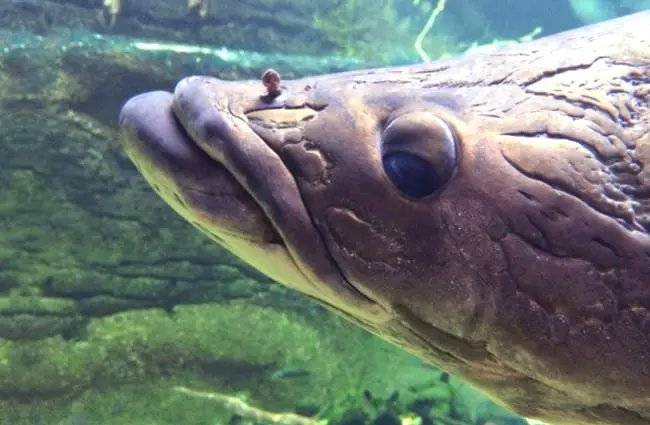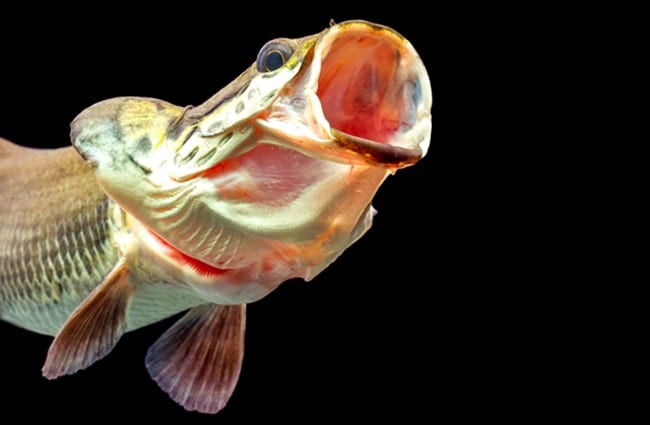Unveiling the Amazon’s Gentle Giant: The Magnificent Arapaima
Deep within the emerald embrace of the Amazon rainforest swims a creature of mythic proportions, a living relic from an ancient past: the Arapaima. Known by many names, including Pirarucu in Brazil and Paiche in Peru, this colossal freshwater fish captivates with its sheer size, unique adaptations, and profound connection to its environment and the people who share its waters. Far more than just a big fish, the Arapaima is a cornerstone of its ecosystem, a marvel of evolution, and a testament to the Amazon’s enduring biodiversity.

A Glimpse at the Giant: Basic Biology and Habitat
The Arapaima (Arapaima gigas, though recent research suggests multiple species exist within the genus) is one of the largest freshwater fish on Earth, regularly reaching lengths of over 6.5 feet (2 meters) and weights exceeding 220 pounds (100 kg). Exceptional specimens have been reported to grow even larger, pushing towards 10 feet (3 meters) and 440 pounds (200 kg). Its body is elongated and somewhat compressed, adorned with large, greenish-black scales that shimmer with a reddish hue towards the tail, giving it a distinctive and beautiful appearance.
This magnificent fish is an obligate air-breather, a crucial adaptation for survival in its often oxygen-depleted habitat. It possesses a modified swim bladder that functions much like a lung, allowing it to gulp air from the surface every 5 to 15 minutes. This behavior is not only vital for its survival but also offers a unique opportunity for observers to spot these elusive giants.
Where the Giants Roam: Arapaima’s Habitat
Arapaima are endemic to the Amazon and Essequibo river basins in South America. Their preferred habitat consists of the slow-moving, warm, and often oxygen-poor waters of floodplains, oxbow lakes, and large rivers. These environments are characterized by seasonal fluctuations, with periods of high water during the rainy season and low water during the dry season. The Arapaima thrives in these conditions, often seeking refuge in the calmer, shallower waters of lagoons and flooded forests where they can easily access the surface to breathe.
For the aspiring animal lover hoping to find an Arapaima in the wild: Locating an Arapaima requires patience and local knowledge. Focus your search on the calmer, nutrient-rich waters of oxbow lakes and flooded forests, particularly during the dry season when fish are concentrated in smaller bodies of water. The most telling sign of an Arapaima’s presence is its characteristic gulping of air at the surface, a sound that can carry across the water. Observing from a respectful distance, perhaps with a local guide, offers the best chance of a sighting without disturbing these majestic creatures.

The Apex Predator’s Plate: Arapaima’s Diet and Role in the Ecosystem
As an apex predator in its freshwater domain, the Arapaima plays a vital role in maintaining the balance of the Amazonian ecosystem. Its diet primarily consists of other fish, but it is an opportunistic feeder and will also consume crustaceans, insects, and even small land animals that venture too close to the water’s edge, such as birds or small mammals. Arapaima are ambush predators, using their powerful tails to propel themselves forward and engulf prey with their large, cavernous mouths.
Their presence helps regulate populations of smaller fish species, preventing overpopulation and ensuring the health of the aquatic food web. By preying on a variety of animals, they contribute to the natural selection process, helping to maintain robust and diverse fish communities.

A Journey Through Time: Arapaima’s Evolutionary History
The Arapaima is often referred to as a “living fossil” due to its ancient lineage and primitive characteristics. It belongs to the order Osteoglossiformes, a group of bony-tongued fish that originated during the Jurassic period, over 150 million years ago. Its unique air-breathing capability, large scales, and general body plan are reminiscent of early fish forms, providing a fascinating window into the evolutionary past of vertebrates.
The Arapaima’s scales are particularly remarkable. They are incredibly tough and mineralized, forming a natural armor that provides exceptional protection against predators, most notably the piranha. This evolutionary adaptation highlights the intense selective pressures faced by species in the Amazon, where survival often depends on robust defenses.
The Dance of Life: Mating and Reproduction
Arapaima exhibit fascinating reproductive behaviors, showcasing dedicated parental care. Breeding typically occurs during the low-water season, allowing the young to emerge and grow during the subsequent high-water season when food resources are abundant. The male Arapaima constructs a nest, usually a shallow, circular depression in the sandy bottom of a calm, clear water body.
Once the eggs are laid and fertilized, the male takes on the primary role of guarding the nest and later, the fry. He protects them fiercely from predators, and it is believed that he produces a pheromone from a gland in his head that attracts and guides the schooling young. The female may also remain nearby, contributing to the protection of the offspring. This extended parental care is relatively rare among fish and significantly increases the survival rate of the young Arapaima, a crucial strategy for a species that produces fewer, larger offspring compared to many other fish.

Arapaima and Humanity: Culture, Conservation, and Coexistence
For centuries, the Arapaima has been an integral part of human culture in the Amazon basin. Indigenous communities have traditionally relied on it as a significant food source, utilizing its meat, scales, and even its bony tongue. The scales, known for their strength and beauty, have been used in crafts, jewelry, and even as nail files. The fish’s local names, such as Pirarucu (meaning “red fish” in Tupi, referring to the reddish markings on its tail) and Paiche, reflect its deep cultural significance.
Conservation Challenges and Efforts
Despite its importance, the Arapaima has faced significant threats, primarily from overfishing. Its large size, slow growth rate, and predictable air-gulping behavior make it particularly vulnerable to capture. This led to a drastic decline in populations in many areas, prompting serious conservation concerns.
However, there are success stories. Sustainable fishing practices, often managed by local communities, have shown promising results. These programs typically involve quotas, size limits, and seasonal closures, allowing Arapaima populations to recover. Aquaculture, the farming of Arapaima, is also gaining traction as a way to meet market demand while reducing pressure on wild stocks. These efforts are crucial not only for the survival of the Arapaima but also for the ecological health and economic well-being of the Amazonian communities.

Practical Insights for Different Audiences
For the Aspiring Zoologist
Studying Arapaima offers a rich field of research. Focus areas could include:
- Physiological Adaptations: Delve deeper into the mechanics of its air-breathing apparatus and its unique scale structure.
- Population Genetics: Investigate the genetic diversity across different river basins to understand species delineation and population health.
- Behavioral Ecology: Observe social interactions, territoriality, and the nuances of parental care in both wild and captive settings.
- Conservation Biology: Evaluate the effectiveness of different management strategies and explore new approaches to sustainable aquaculture.
For the Hiker Encountering an Arapaima in the Wild
If fortunate enough to spot an Arapaima, remember these guidelines:
- Observe from a Distance: Maintain a respectful distance to avoid disturbing the fish or its habitat.
- Do Not Interfere: Do not attempt to touch, feed, or capture the fish. It is a wild animal and should be treated with caution and respect.
- Appreciate the Moment: Such encounters are rare and special. Take a moment to appreciate this magnificent creature in its natural environment.
- Report Sightings (if applicable): In some protected areas, reporting rare sightings to park rangers or local conservation groups can contribute to monitoring efforts.
For the Zookeeper Caring for an Arapaima
Caring for Arapaima in captivity requires specialized knowledge and significant resources:
Tasks to Perform:
- Spacious Enclosure: Provide an extremely large aquarium or pond that can accommodate its immense size and growth potential.
- Water Quality Management: Maintain pristine water parameters, including temperature (typically 75-82°F or 24-28°C), pH (neutral to slightly acidic), and low ammonia/nitrite levels. Regular, large water changes are essential.
- Appropriate Diet: Offer a varied diet of high-quality, appropriately sized fish, crustaceans, and specialized pellets. Ensure nutritional balance to prevent deficiencies.
- Environmental Enrichment: Provide hiding spots and open swimming areas. While not highly social, enrichment can reduce stress.
- Health Monitoring: Regularly observe behavior, appetite, and physical condition for any signs of illness or stress.
- Breeding Programs: If part of a breeding program, carefully monitor reproductive cycles and provide suitable nesting sites.
Tasks to Avoid:
- Overcrowding: Housing too many Arapaima or other large fish in an inadequate space leads to stress, aggression, and poor health.
- Poor Water Quality: Neglecting water filtration and maintenance can quickly lead to disease and mortality.
- Inappropriate Diet: Feeding an unbalanced diet or low-quality food can cause nutritional deficiencies and health problems.
- Sudden Environmental Changes: Rapid fluctuations in water temperature, pH, or other parameters can be highly stressful.
- Rough Handling: Arapaima are powerful fish. Any handling should be done by experienced personnel with appropriate equipment to minimize injury to both fish and keeper.
A Huge List of Interesting Facts About Arapaima
- The Arapaima can survive for up to 20 minutes without surfacing for air, thanks to its lung-like swim bladder.
- Its scales are so strong that they are being studied by scientists for their potential in developing new types of body armor.
- Arapaima are known to make a distinctive coughing sound when they surface to breathe.
- They are mouthbrooders, meaning the male carries the young in his mouth for protection, though this is debated and more commonly refers to the male guarding the nest and fry closely.
- The name “Pirarucu” comes from the Tupi words “pira” (fish) and “urucum” (red), referring to the reddish markings on its tail.
- Arapaima can leap out of the water, especially when startled or hunting.
- They have a bony tongue, which is sometimes dried and used as a grater by local communities.
- Despite their size, Arapaima are generally docile towards humans, though their immense power demands respect.
- Their growth rate in aquaculture can be quite rapid under optimal conditions, making them a promising species for sustainable food production.
- The Arapaima’s ability to breathe air allows it to survive in waters where most other fish would perish due to lack of oxygen.
Conclusion: A Legacy Worth Protecting
The Arapaima stands as a magnificent emblem of the Amazon’s unparalleled biodiversity. From its ancient evolutionary roots and unique physiological adaptations to its complex reproductive strategies and vital role in the ecosystem, this giant fish is a source of endless fascination. Its story is also a powerful reminder of the delicate balance between human needs and wildlife conservation. By understanding and appreciating the Arapaima, we not only celebrate a truly remarkable creature but also commit to safeguarding the future of the Amazon and all its incredible inhabitants.

![Red Angus Closeup of a beautiful Red Angus cowPhoto by: U.S. Department of Agriculture [pubic domain]https://creativecommons.org/licenses/by/2.0/](https://animals.net/wp-content/uploads/2020/03/Red-Angus-4-238x178.jpg)




![Red Angus Closeup of a beautiful Red Angus cowPhoto by: U.S. Department of Agriculture [pubic domain]https://creativecommons.org/licenses/by/2.0/](https://animals.net/wp-content/uploads/2020/03/Red-Angus-4-100x75.jpg)

